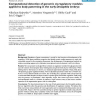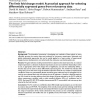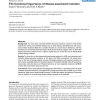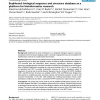BMCBI
2002
13 years 11 months ago
2002
Background: Total sequence decomposition, using the web-based MASIA tool, identifies areas of conservation in aligned protein sequences. By structurally annotating these motifs, t...
BMCBI
2002
13 years 11 months ago
2002
Background: For effective exposition of biological information, especially with regard to analysis of large-scale data types, researchers need immediate access to multiple categor...
BMCBI
2002
13 years 11 months ago
2002
Background: The identification of species or species groups with specific oligo-nucleotides as molecular signatures is becoming increasingly popular for bacterial samples. However...
BMCBI
2002
13 years 11 months ago
2002
Background: Expressed sequence tags (ESTs) are single pass reads from randomly selected cDNA clones. They provide a highly cost-effective method to access and identify expressed g...
BMCBI
2002
13 years 11 months ago
2002
Background: The biomedical community is developing new methods of data analysis to more efficiently process the massive data sets produced by microarray experiments. Systematic an...
BMCBI
2002
13 years 11 months ago
2002
Background: For many years, scientists believed that point mutations in genes are the genetic switches for somatic and inherited diseases such as cystic fibrosis, phenylketonuria ...
BMCBI
2002
13 years 11 months ago
2002
Background: SeqHound has been developed as an integrated biological sequence, taxonomy, annotation and 3-D structure database system. It provides a high-performance server platfor...
BMCBI
2002
13 years 11 months ago
2002
Background: Pattern matching is the core of bioinformatics; it is used in database searching, restriction enzyme mapping, and finding open reading frames. It is done repeatedly ov...
BMCBI
2002
13 years 11 months ago
2002
Background: DNA microarray technology is a powerful technique that was recently developed in order to analyze thousands of genes in a short time. Presently, microarrays, or chips,...




